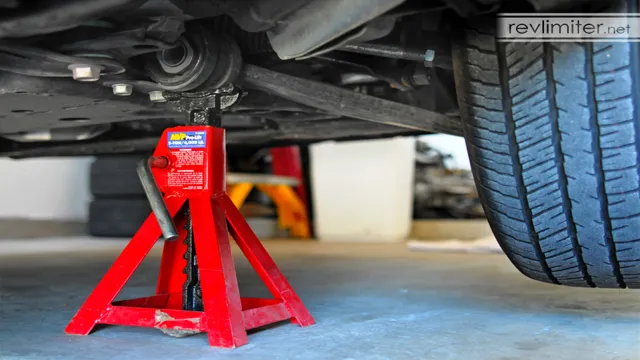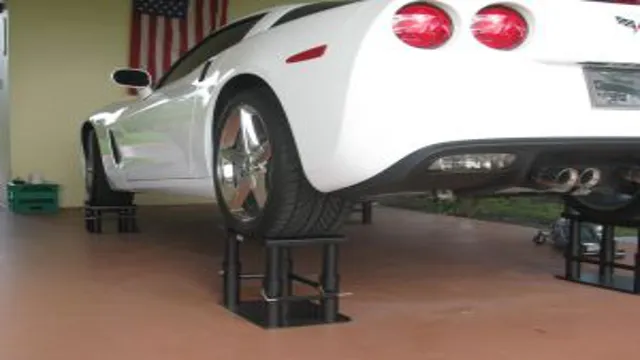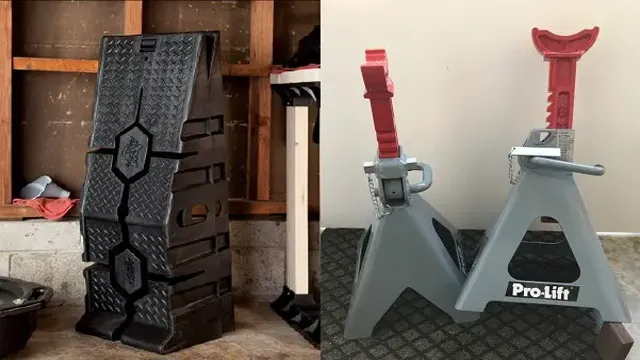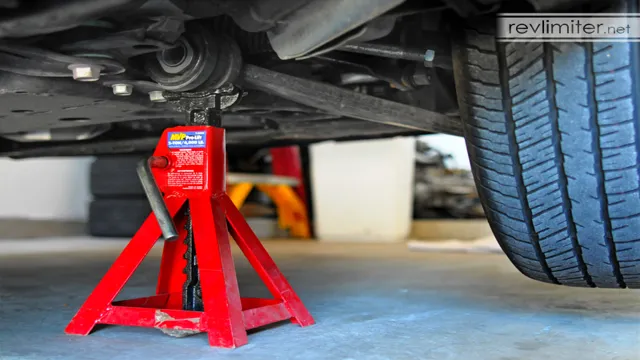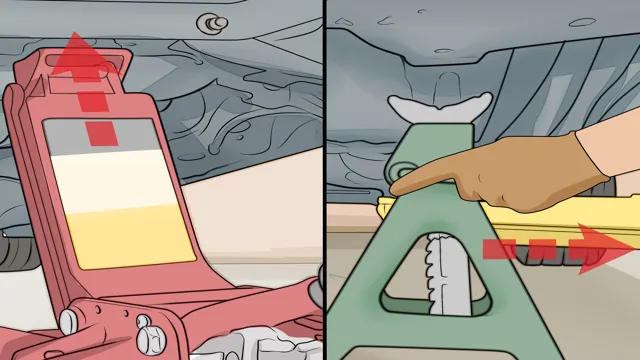Where to Put Jack Stands on a Unibody Car: A Step-by-Step Guide for Safe Lifting

As a responsible car owner, you must always ensure that your vehicle is maintained regularly and serviced when necessary. One aspect of car maintenance that many people overlook is the importance of using jack stands when working on their cars. Jack stands provide a stable platform for your car, keeping it secure while you work on it.
For unibody cars, in particular, jack stands need to be placed carefully to avoid damaging the frame. In this blog post, we’ll discuss where to place jack stands on a unibody car to ensure that your vehicle stays safe and secure while you’re working on it. So, let’s dive in and take a closer look at this essential aspect of car maintenance.
Introduction
Where to put jack stands on a unibody car is a common question for car owners who want to perform maintenance or repairs. Unibody cars do not have a traditional frame and require caution when using jack stands. The best place to put jack stands on a unibody car is on the pinch welds, which are located underneath the car’s side panels.
It is important to avoid placing jack stands on suspension components or other vulnerable areas of the car to prevent damage. Always check the owner’s manual for specific instructions and use a quality set of jack stands that can support the weight of the car. By taking the proper precautions and using the right equipment, car owners can safely lift and support their unibody cars for maintenance or repairs.
Why Proper Placement of Jack Stands is Important
When it comes to working on your car, safety should always be your top priority, and proper placement of jack stands is a crucial aspect that should not be overlooked. Jack stands are essential tools that help lift the car securely and enable comfortable access to the undercarriage. Placing them incorrectly can result in damage to your car or, even worse, injure you.
Imagine the stand falling, causing your car to crush your leg or foot. It’s essential to understand the right placement of jack stands to avoid such situations. Therefore, make sure you place the stands on a firm, level surface, and always use at least two stands to ensure stability.
Remember to place them in a position that doesn’t interfere with the work area, and always test them before using them to lift the car. By following these safety measures, you can prevent accidents and work on your car with confidence.

What is a Unibody Car?
Unibody Car. A unibody car is a type of vehicle that doesn’t have a separate frame and body. Instead, the body of the car is built around a single structure that provides its overall support.
This type of construction means that the car’s body and frame are integrated into one robust piece, providing increased strength and durability. Unibody cars are generally lighter than their body-on-frame counterparts, which helps to improve fuel efficiency and handling. They are also typically more aerodynamic, which means they can offer better performance at high speeds.
Despite their many benefits, unibody cars can be more expensive to repair following a collision, as they require specialized equipment and techniques to restore their structural integrity.
Locating Safe Jack Points on a Unibody Car
When it comes to locating safe jack points on a unibody car, it’s important to take your time and do it right. Working with the wrong areas can damage your vehicle’s frame and put your safety at risk. So how do you do it? First, consult your car manual to see if it has any specific recommendations for your make and model.
Generally, the front and rear pinch welds are the safest spots to use as jack points. These are the raised, reinforced areas located just behind or in front of the tires. Place the jack stands on these points and double-check that they are level and stable before continuing your work.
Remember, the key is to take your time and do it right.
Refer to your Owner’s Manual
When it comes to lifting a car, it’s essential to locate the safe jack points to prevent damage or accidents. For a unibody car, the owner’s manual is the best resource for finding these points. Manufacturers design and test cars to ensure they are structurally sound and provide recommendations on where to jack up the car without causing damage.
You can usually find this information in the maintenance or service chapter of the manual. It’s crucial to follow the manufacturer’s guidelines as they know their car better than anyone else. The owner’s manual is not only helpful when locating safe jack points, but it’s also a valuable resource for proper maintenance and care of your vehicle.
So, make sure to keep your owner’s manual handy and refer to it when necessary to keep your car in top shape.
Check Internet Resources for Your Specific Car Model
When it comes to jacking up your car, it’s important to locate safe jack points to avoid damaging the unibody structure. While every car model is different, there are a variety of internet resources available to help you find the appropriate lifting points for your specific vehicle. One useful resource is the owner’s manual, which often includes diagrams or descriptions of the recommended jack points.
Additionally, many car forums or manufacturer websites feature forums where you can ask other car owners for advice or locate specific instructions for your car model. It’s important to take your time when locating these jack points and to double-check your information to ensure safety. Remember, taking shortcuts or guessing can lead to costly damage or even accidents.
By doing your research and finding the appropriate jack points, you can safely jack up your car and perform necessary repairs and maintenance.
Look for Indicators on Your Car’s Body
When it comes to lifting your vehicle, it’s crucial to locate safe jack points on a unibody car. These jack points indicate the areas of the frame that can safely support the weight of your vehicle, protecting the body from bending or damage during the lift. The most common safe jack points on a unibody car are usually located on the reinforced rocker panels or designated notches along the frame.
You can also look for factory-recommended jack points, which are usually marked with arrows or symbols near the rear and front axles. By paying attention to these subtle indicators on your car’s body, you can ensure a safe and efficient lifting process while preventing any costly repairs or injuries down the road. Remember to consult your owner’s manual or a trusted mechanic for specific details on locating safe jack points for your particular make and model.
Use a Portable Vehicle Lift
If you’re looking to use a portable vehicle lift for your unibody car, it’s critical to know the safe jack points. Unlike traditional body-on-frame vehicles, unibody cars don’t have any clear areas to put a floor jack or jack stands. Instead, it’s important to ensure that you’re putting your jack or lift on a solid area of the car that can support the weight.
One option is to use the vehicle’s subframe, which tends to be the strongest part of the car’s undercarriage. However, it’s important to make sure that the lift pad is placed in an area that won’t damage components like brake lines or fuel lines. Another option is to utilize pinch welds, which are specifically designed to support lifting equipment.
However, not all pinch welds are created equal, so make sure you’re using a lift pad that’s the right size and shape for your specific car. By understanding the safe jack points for your unibody car, you can feel confident using a portable vehicle lift and safely working on your vehicle.
Safety Precautions when Using Jack Stands
When using jack stands for maintenance or repair work on your unibody car, it is crucial to take safety precautions to avoid accidents or damages. One of the most important things to consider is where to place the jack stands on the car’s structure. For a unibody car, it is recommended to use the factory jacking points or designated reinforced areas to place the jack stands.
These areas are usually indicated in the car’s manual or by the manufacturer. Placing the jack stands on unsupported areas of the car’s structure can lead to warping or crushing, potentially causing the car to collapse and harm you or your vehicle. Therefore, it is essential to confirm the proper locations to place jack stands before starting any work.
Additionally, it is vital to check the weight limit of the jack stands and ensure they can support your car’s weight before using them. By taking these safety precautions, you can work on your car with confidence and peace of mind.
Always Use an Appropriate Size Jack Stand
When working on your vehicle, it’s important to take all necessary precautions to ensure your safety. One essential tool in any garage is a set of jack stands. However, it’s important to remember that not all jack stands are created equal.
Always make sure to use a jack stand that is an appropriate size for your vehicle. Using a stand that is too small for your car can cause it to collapse, putting you at risk for injury. Additionally, always make sure to place the jack stand on a flat, stable surface and double-check that it is securely holding the weight of your vehicle before working underneath it.
By following these simple safety precautions, you can rest easy knowing that you are taking the necessary steps to protect yourself while working on your vehicle.
Use Wheel Chocks or Blocks
If you’re planning to use jack stands to lift your car, it’s essential to follow some safety precautions to prevent any accidents. One of the most vital precautions is to use wheel chocks or blocks. These are small wedge-shaped tools placed in front of or behind your car’s wheels to keep them in place.
They work by preventing the tires from moving when you lift your car with jack stands. It’s crucial to use wheel chocks or blocks on both sides of your car, even if you’re using jack stands on one side. This way, if anything goes wrong, the wheels will be prevented from rolling and causing a dangerous situation.
Using wheel chocks or blocks is an easy and affordable way to ensure your safety when working with jack stands. Don’t skip this crucial step to avoid any potential accidents.
Avoid Exceeding Jack Stand’s Weight Capacity
Jack Stand’s Weight Capacity When it comes to lifting your car with a jack stand, it’s essential to consider safety precautions before you start working on the vehicle. One of the most important things to consider is the capacity of the jack stand you’re using. Many people make the mistake of using a jack stand that can’t support the weight of their car, which can lead to disastrous consequences.
To avoid this, you should always check the weight capacity of the jack stand you intend to use and ensure that it can handle the weight of your car. Most jack stands come with a weight rating that tells you the maximum weight they can handle. If your car weighs more than the jack stand’s rating, then you should look for a higher-rated stand.
Remember that exceeding the weight capacity of a jack stand can cause it to collapse and can result in serious injuries or even death. So, don’t take the risk: always use a jack stand that can handle the weight of your car.
Inspect Jack Stands Before Use
When it comes to working on your vehicle, safety should be your number one priority. One of the most important safety precautions to take is to inspect your jack stands before use. Jack stands are an essential tool for lifting and supporting vehicles while you work on them.
However, if they are not properly maintained, they can be dangerous and lead to serious accidents. The first thing to check is the weight capacity of the jack stand to ensure it can carry the weight of your vehicle. It’s also important to check the condition of the jack stand itself, looking for any cracks, rust, or damage that could affect its stability.
Always use jack stands on a level surface, and never overload them beyond their weight capacity. By taking these simple safety precautions and inspecting your jack stands before use, you can ensure you and your vehicle are safe while you work on it.
Conclusion
In conclusion, placing jack stands on a unibody car requires a delicate touch and a keen eye for detail. One must take care to locate the designated jacking and supporting points, ensuring that the weight of the vehicle is evenly distributed and balanced. It’s a bit like performing a high-wire act, only instead of a circus tent, you’re using a garage floor as your stage.
So, remember to use caution and common sense, and always double-check your work. With a little practice and attention to detail, you’ll soon be raising your car like a pro!”
FAQs
What is a unibody car?
A unibody car is a type of vehicle where the body and frame are a single unit.
Where are the safest places to put jack stands on a unibody car?
The safest places to put jack stands on a unibody car are on the designated jack points, which can usually be found in the owner’s manual or on the underside of the car.
Can you use regular jack stands on a unibody car?
Yes, you can use regular jack stands on a unibody car as long as they are placed on the designated jack points.
What is the weight capacity of jack stands for a unibody car?
The weight capacity of jack stands for a unibody car will vary depending on the specific model and brand. It is important to check the weight capacity before use.
How many jack stands do I need for a unibody car?
It is recommended to use at least two jack stands for safety when lifting a unibody car.
Can I lift both sides of a unibody car at once with jack stands?
It is not recommended to lift both sides of a unibody car at once with jack stands, as it can cause damage to the car’s structure. It is best to lift one side at a time.
What should I do if the designated jack points on my unibody car are damaged or rusted?
If the designated jack points on your unibody car are damaged or rusted, it is important to have them repaired by a professional before attempting to lift the car with jack stands.


